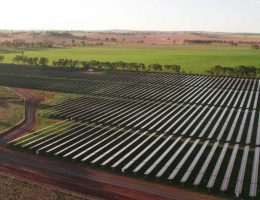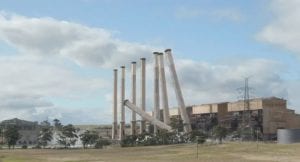In December 2016, something unforgettable happened, and was immediately forgotten.
BHP’s Olympic Dam mine site saw its supply of electrical power interrupted by a network fault. It’s the fourth largest copper deposit and largest known single deposit of uranium on the entire planet. It’s a big deal. So when the headlines began pouring out claiming the mine had been “blacked out” by South Australia’s power grid, only three months after a major and also unforgettable (but not forgotten) blackout in South Australia, the temptation could not be resisted.
“The challenge to reduce emissions and grow the economy cannot fall to renewables alone,” BHP Chief Andrew Mackenzie told the Associated Press. “This is a wake-up call ahead of the Coag meeting and power supply and security must be top of the agenda and urgently addressed.”
Guess who checked to see whether the Olympic Dam mine had actually been “blacked out” for four hours, as nearly every media outlet had claimed? Yes, it was RenewEconomy’s editor Giles Parkinson – who found that the Olympic Dam mine had had its demand level decreased by order of the grid operator from 170 megawatts to 100 megawatts to help stabilise the grid when power was being restored after the fault at the transmission line.
SA Labor's expensive and unreliable electricity system was exposed last night. Will blackouts be Jay Weatherill's legacy? #saparli
— Steven Marshall (@marshall_steven) November 30, 2016
The report also highlights two wind farms were disconnected from the grid as a consequence of the line failure. BHP is, of course, heavily invested in extracting and selling thermal coal, a direct competitor to wind power. How could they have resisted the urge to twist the facts – turning a brief demand reduction into a full-scale “blackout” and blaming renewables for a blackout caused by a transmission line failure?
The curious case of Tomago
As I have written recently and covered in my book Windfall: Unlocking a Fossil Free Future, the September 2016 blackout in South Australia shifted energy policy completely and permanently away from climate change, and locked it into a focus purely on reliability and economics. The most recent example: Australia’s government has announced it’s going to build a gas-fired power station at a breezy $600 million of taxpayer’s cash, and justified it on the grounds that it improves reliability and brings down power prices.
Angus Taylor was specific about why it was needed.
“To give you a sense of how much it is needed in the market, in the last week, Sabra, we have seen the Tomago smelter, the biggest electricity consumer in Australia, have to shut 600 megawatts – the equivalent of this generator – three times because there wasn’t enough power available”
The key word there is “have”. Tomago did not ‘have’ to do anything – it was not ordered to, by Australia’s grid operator, through the mechanisms available when there’s a supply crunch. As University of Melbourne researcher Dylan McConnell found, there were two brief moments when demand fell by 600 megawatts, but that was in response to price spikes. At least one peaking gas plant, Snowy Hydro’s Colongra, did not switch on, despite being available.
Tomago smelter responding to price spikes last week.
Despite some reporting – no forced outages.
For the NEM nerds – there was no actual LOR's or RERT activations. pic.twitter.com/HifnstuPeJ
— Dylan McConnell (@dylanjmcconnell) May 23, 2021
“It seems to have been a purely commercial decision”, McConnell told me, suggesting Taylor was trying to justify the spending of public money on the Kurri Kurri gas plant. But it certainly “doesn’t strengthen the case for Kurri Kurri”, he said. “It strongly suggests Snowy Hydro isn’t the appropriate participant to build it, given it’s already substantial market share (even more so with completion of the 2000MW Snowy 2.0 project)”.
when @AngusTaylorMP told @SabraLane that tomago was forced to shut down last week because there was a shortage of power, he was lying. 🤥
he’s been gaslighting on energy for two decades, long before he became our worst energy minister ever. #auspol https://t.co/AHlzllAAQu
— 💧simon holmes à court (@simonahac) May 23, 2021
Tomago is Australia’s single largest energy user, and frequently plays a large role in public discussions around reliability and security of supply. After blackouts in 2018, chief Matt Howell said “This is the likely future of our energy grid as once reliable baseload generators exit the National Energy Market and are mostly replaced with intermittent wind and solar projects with no practical storage to speak of”.
And when Taylor announced the Kurri Kurri plant, Tomago’s CEO Hatt Howell told the AFR that “We absolutely support the need to transition to cleaner energy sources but we need dispatchable gas generation to keep the lights on as we do”, and that “It’s not going to be solar that fills that void and it’s not going to be wind when there is no wind”. Howell also directly stated that if the plant hadn’t reduced its output, there would have been widespread blackouts in NSW, despite no ‘lack of reserve’ notice or forced outage direction from the Australian Energy Market Operator. “We think it is a very prudent and responsible measure to go ahead with this power station because the reality is, the reason the lights and heaters stayed on last night is because Tomago came off.”
There is something relatively odd happening in New South Wales, at the moment. The government consumer protection body is investigating these frequent price spikes. “We understand that some of the big generators who own peaking gas plants, have not turned them on, which of course is making the market price unnecessarily high at times of high demand”, CEO of utility Enova, Alison Crook, told shareholders. “There may also be some element of demonstrating the “need” for gas in what is occurring. I have just finished writing to the Chair of the ACCC to ask him to investigate”.
The narrative here is baffling. Tomago’s CEO has previously referred to the smelter’s demand response capability as something to be proud of – a key component of flexible demand in a high-renewable grid. “We’ve got a very large load that can come off in a very short space of time to avoid large-scale rolling blackouts, and that has value,” he said last year. That fine-tuned dance between fluctuating supply and flexible demand has been recognised as the future of grids. But when the smelter voluntarily responds to price signals, that’s the sign of ‘too much renewable energy’ and not enough fossil fuels? Which line are we meant to believe, here?
Of course, none of this is meant to make sense. Since the 26th of September 2016, the discourse on blackouts and reliability has been dictated purely by the excited imaginations of fossil fuel advocates. The circumstances surrounding these ‘blackout’ justifications for new, taxpayer-funded fossil fuel plants are deeply suspect, and it’s likely to get worse as the government’s efforts to prop up fossil fuels get worse.










